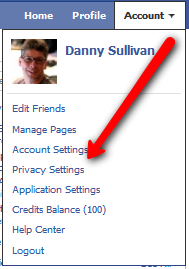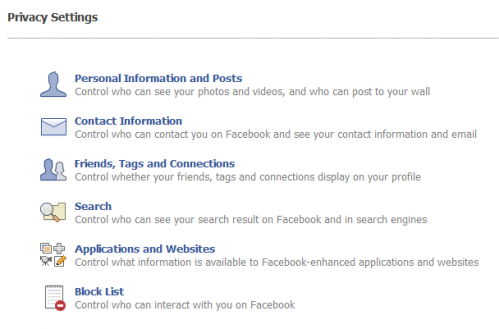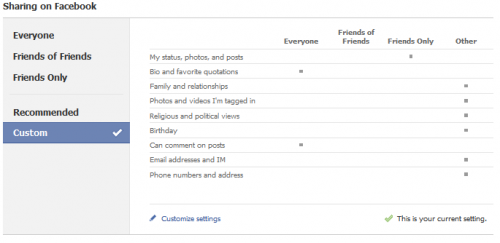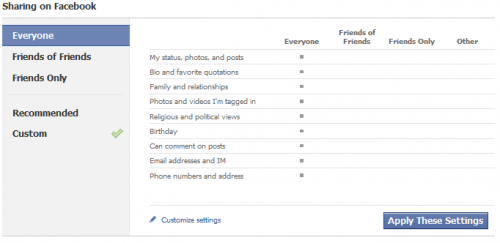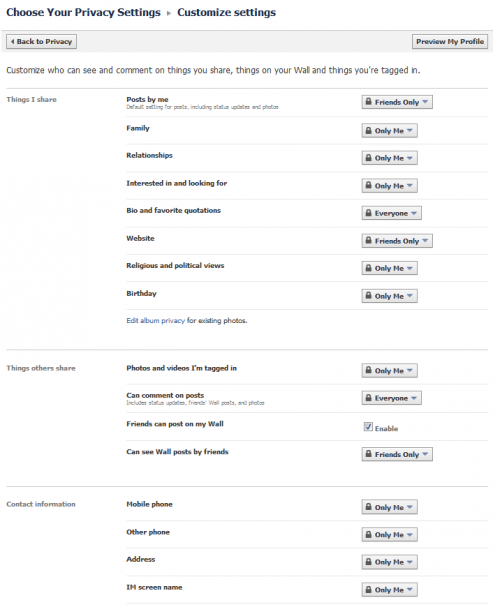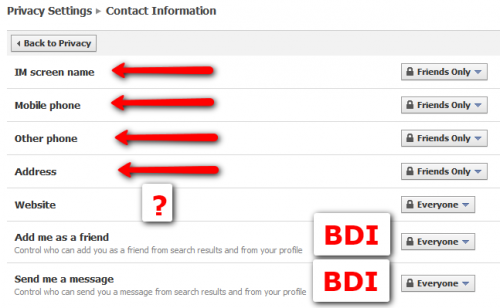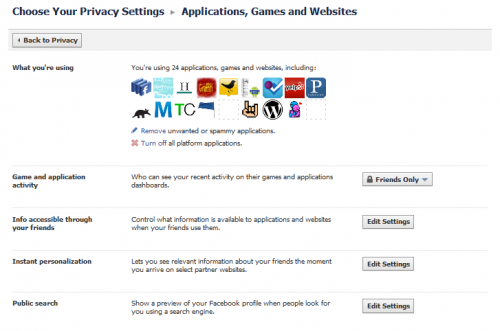Drill (Down), Baby, Drill: Facebook’s New “Simple” Privacy Settings Still Pretty Complex
Today, Facebook announced new simplified privacy controls designed to ease a settings overload problem that it admitted has challenged its users. Did it succeed? I’d give it an A for effort but a C+ to B- for actually solving the overload problem. Rather than a “one click solution” or a single-page recap, there remains a […]
Today, Facebook announced new simplified privacy controls designed to ease a settings overload problem that it admitted has challenged its users. Did it succeed? I’d give it an A for effort but a C+ to B- for actually solving the overload problem. Rather than a “one click solution” or a single-page recap, there remains a “flowchart” of options. Though less daunting than in the past, the complexity may still leave users feeling there are too many controls to be in control.
Below, a “Before” and “After” comparison. The “Before” screens are what most people on Facebook currently see, when they visit their privacy settings. The “After” is what they’ll get in the coming weeks and which can be previewed here. A small number people already have access to the new controls, including many reporters who participated in Facebook’s privacy press conference today. I was one of those reporters, so the “After” screens below are drawn from what I see in my personal account.
The Privacy Settings Page
Regardless of whether you have the current “Before” or forthcoming “After” privacy controls, everything starts by selecting the Privacy Settings option from the Account menu, when you’re logged into Facebook:
Select that option, and you’re taken to the main Privacy Settings page. This is what’s been redesigned.
Here’s the Before look, what most people still currently see:
Here’s the After:
As you can see, the Before screen divided privacy settings into six major subsections:
- Personal Information and Posts
- Contact Information
- Friends, Tags and Connections
- Search
- Applications and Websites
- Block List
In contrast, the After screen displays one area of privacy settings without requiring any drill-down and has three subsections beyond this. That’s four major control areas in all:
- Basic Directory Information
- Sharing on Facebook
- Applications and Websites
- Block Lists
Drill, Baby, Drill
Yes, it’s a reduction. However, it’s a far cry from the simplified structure some wanted and that Facebook claims to have delivered. To fully understand how Facebook may be sharing your information, you have to drill-down into three of the four major areas. Once in some of these, there is further drilling to do. It’s less work than in the past, but there’s still a whole lot of drilling going on.
Most important, despite reading story after story about how Facebook has rolled out a way to set a “default” restriction across all your privacy settings, that’s just not the case. You can do it across one set of privacy options (Sharing On Facebook), but not across two other major sets (Basic Directory Information and Applications & Websites).
“Sharing On Facebook” Settings
Facebook deserves kudos for the impressive new “Sharing On Facebook” area. This area dominates the main Privacy Settings page. You can see what you’re sharing with whom, at a glance, no drill-down required. And yes, there is a “one click” solution to change your settings.
Here’s how the new settings look in my personal account:
You can see that I’ve chosen to share some things like my bio with everyone, while other things like my status updates only get shared with friends. I also have some “Other” settings, set using the Customize settings link at the bottom of the page above. These allow for sharing with particular people or “Only Me.”
With a click, I can reset my sharing to open up to the world. For example, I can go with Facebook’s “Recommended” settings, which share some items with only with friends, some with friends and their friends (friends of friends) and some with everyone:
Similarly, I can share all the listed items with everyone, with a click:
I can restrict everything to just friends, or to friends of friends or use custom options such as I mentioned:
Three Screens Into One
Previously, setting privacy levels for the items listed in the new “Sharing on Facebook” screen required drilling into three separate areas. One was the “Personal Information and Posts” section:
The arrows show how most of the controls in this “Before” page have moved into the new “After” Sharing page. That makes them more accessible than in the past. The settings include who can see your bio, your birthday or your religious and political views. That’s assuming you’ve actually put some of this information on Facebook at all. You have to provide a name, birthdate, gender and email. But that’s it. You’re not required to state a political stance. And you’re only required to share your name and gender.
Notice the question mark next to the “Interested in and looking” item. This is part of the new Sharing on Facebook page, but you’ll only find it listed if you drill into the custom settings for that page. I suspect this is an oversight. “Posts By Friends” is buried in the same way.
Some options from the old Contact Information page have also migrated to the new Sharing page:
Notice the return of the question mark, in relation to whether you share your website address. That’s part of the new “Sharing on Facebook” page, but again, you only get to it by drilling down into custom options. And again, I suspect this is an oversight — but it’s not reassuring to discover there’s hidden stuff like this not shown on the at-a-glance view, even if the information itself is fairly harmless.
As for those two items marked BDI — stay tuned. I’ll get back to them. But first, one more old screen, the former “Friends, Tags and Connections” settings page, which also sees a number of items migrate over to the new Sharing page:
Yes, another question mark, this for who you share Activities with. I have no idea where the Activities privacy controls are now located in the new system. I’ve looked and looked. I suspect this might be one of those mysterious BDI items I keep mentioning. In fact, you’ll see that the former “Friends” page illustrated above has a bunch of these items. Time to talk about that….
BDI: Basic Directory Information
Clearly, consolidating information from three pages, all of which required users to drill-down into privacy settings, into a single at-a-glance page is a big improvement. Having it all front-and-center makes life easier. That’s why it’s so disappointing that the remainder of Facebook’s options also weren’t centralized.
For example, at the top of the Privacy Settings page is a new “Basic Directory Information” section:
This informs you that to “help” your “real-world friends” to find you, there’s some basic information about yourself that Facebook will always share with the public. There’s other information in addition to this that you can control. Want to know what that information is? Then it’s drill-down time:
You’re told in text at the top of the page that your name, gender plus any profile picture you provided and any networks you joined are made public to the world, with an explanation that this is done to help people find you. Better, in my view, would have been to list each of these as a separate line item — or at least group them as a single line, with a button-like message saying “Always Public.” That would help those who are trying to review things at-a-glance, in this section.
This section is also the home to all those things I tagged as “BDI” from the old privacy pages at Facebook, BDI meaning they’re part of the new Basic Directory Information section. Not everything is clean cut, however. As I said earlier, I couldn’t find where the control for sharing “Activities” has now gone. Is it part of the “See my interests and other Pages” section of BDI? I can’t tell. The former “Add me as friend” control also seems to have gone, though perhaps it’s now transformed into the BDI’s “Send me friend requests” setting.
Also on the BDI page are new controls letting you keep your friends and pages you like private. This is important (and not exactly foolproof, when it comes to friends). I’ll get back to this, but first, another feature on the BDI page. It picks up a control previously found in the old systems “Search” page:
If you don’t want to be found by those searching within Facebook, the option to block discovery now resides here. But oddly, if you don’t want your Facebook profile to be found in external search engines like Google, that control resides in a separate area, the Apps & Websites section, that I’ll discuss further.
I can see some of the logic, since the Apps section is supposed to help you control how external sites interact with Facebook. But it feels more like the search blocking options should have been kept together at least within BDI.
More important, ALL the options on the BDI page feel like they could have been integrated into the at-a-glance table on the main privacy page. They’re all about information that’s “shared,” and all of them but one have the same Friends/Friends Of Friends/Everyone choices as the items on the main page. Why on earth didn’t Facebook do this? I’ll get to Facebook’s explanation at the end of this story. But next, more drilling.
You Can Just Say “No” To Apps — If You Can Find The Option
In my opinion, what’s created the most grief for Facebook lately on the privacy front are people worried about what “applications” — which include web sites — might do with their information.
After Facebook’s F8 developers conference last month, it allowed application makers to pull more information about Facebook users than in the past, and to retain more of that information. It’s clearly hard enough for some people to understand what Facebook itself does with their information. Trying to control third party applications is a severe headache.
Ironically, despite this being a huge area of concern, the controls over applications are buried at the bottom of the Privacy Settings page. This is the Applications & Websites control area:
Want to know about your applications settings. Yes, that’s right. Time to drill-down, once again:
Once you get there, there are further options that you have to digest and frankly, can look scary. For example, here’s what happens if you click on the “Info accessible through your friends” option:
Whoa. I thought I decided this stuff already for Facebook! Now I’ve got to decide all over again if apps can share my bio, my birthday, my videos and so on? Why couldn’t my settings on Facebook as a whole carry along, at least as a default for applications? Or are they? To know, I have to go back out, see what my Facebook settings are and then compare to my application settings.
On the plus side, at least you don’t have to go through the two click process as with the old system to see all the applications you’ve authorized. Instead, all the apps are nicely listed.
This page also has the option to opt-out of Instant Personalization, probably the lightning rod that attracted so much unwanted privacy attention to Facebook after its conference last month. That program automatically passes some information to selected partners sites (only 3 right now). Don’t like that? You could opt out before, and it remains an option here.
Also on this page is the option to block external search engines like Google from finding your profile, which I mentioned before.
Personally, I find understanding what applications might do with my Facebook data difficult. I don’t trust them, and I don’t want to feel like I need to study all this stuff to feel safe. That’s why I love, absolutely love, the ability to completely opt out of application sharing. One click, and you’re done, or so Facebook says.
Did you miss the option? I wouldn’t be surprised. Here it is:
It’s wonderful that Facebook has provided this opt-out. It’s not wonderful that it wasn’t put in its own “row,” like the other controls on this page. It feels buried. At a time when Facebook is trying to rebuild trust, tucking the option away like this screams out like Facebook hopes no one notices it.
Why Not A Single Page? Need To Explain & Not Overwhelm, Says Facebook
After today’s press event, I spoke with several Facebook PR representatives as well as COO Sheryl Sandberg, about how things still felt incredibly complicated. Why couldn’t all this be condensed into a single page?
The answer from everyone was pretty similar. Facebook was concerned that listing all the options would overwhelm the user. It made more sense to focus on highlighting controls around content that people create and post, as these are simple things that can be understood at-a-glance.
I get that. I can see that having a list of 75 “at-a-glance” things might seem overwhelming. But I still feel that it’s even more overwhelming to drill in and still find that there are all those controls around.
It’s like going through a line at Disneyland or another amusement park, only to turn around some blind corner and discover that the line goes further than you thought. I think showing the entire line is better. As least you know what to expect, up front.
Facebook also stressed that when it came to the Basic Directory Information, it was seen as important to put some context about why people might want to share things like their hometown — primarily, so that other people can locate them.
I get that too. I applaud providing more explanation about how information is used right alongside the controls. But contrary to Facebook CEO Mark Zuckerberg’s contention today that revenue was not a factor in the privacy changes, shoving the BDI setting into a corner very much feels like they were.
Perhaps Facebook isn’t aware of this, in the same way that Zuckerberg said there’s a big disconnect in how the company views itself as protecting privacy versus some outside Facebook. But that’s how it plays out.
Consider the explanations, like this one for sharing your hometown:
This helps friends you grew up with and friends near you confirm it’s really you.
Yes, it does. And that helps Facebook, too. And it also means that people you don’t want finding you might do so, such an abusive ex-spouse or former partner, if you start sharing beyond a limited group of friends. None of Facebook’s inline explanations provide reasons NOT to share.
Important (& Welcome Changes) Beyond The Interface
I’ve focused primarily on the new privacy interface, because Facebook said that it was the biggest privacy issue it heard about from users — that the current privacy controls were so overwhelming that they didn’t make people feel they were in control.
Beyond this, it was encouraging that Facebook says that if you don’t want to share your list of friends to the world, you no longer have to. But then again, the control for this option says:
These settings only control the information people can see on your profile. This information, such as your Pages and list of friends, is still public, so it could appear elsewhere on the site and be accessed by applications you and your friends use. Learn more.
So maybe you’re still sharing. I can’t tell yet. I’ll try to dig into it more later.
You also don’t have to share the Facebook Pages that you participate in. Page activity has always been public, so this is actually a big Facebook pullback that it deserves credit for — if it is that you can keep your page activity private, that is, not just the list of pages you follow private. Again, I need to dig more.
It’s disappointing that Facebook didn’t make Instant Personalization an opt-in choice. But then again, I’m still amazed that they are allowing people to opt-out of the entire application “platform” system. As I said, that’s to me been one of the scarier parts of Facebook. I personally take reassurance that I get fire and forget about it. Thank you, Facebook.
Also reassuring was Facebook’s pledge that as it rolls out new products, those products will honor your existing privacy settings. Of course, it remains to be seen how this plays out. Some products may wish to share information not already covered with Facebook’s existing settings.
Another huge change was the removal of “connections,” which — as I understand it — was how Facebook would sometimes show you what a friend or friend-of-a-friend may have been commenting on at Facebook, or liking or so on. Again, it’s another thing I need to better digest, but it’s one of those scary, hard to pin down things that I’m glad to see go.
I hate saying I’m going to dig down more into these other areas later, but covering the interface changes was exhausting enough. Expect a story from us here on Search Engine Land to go further into these other issues. But in the meantime, I’d recommend reading some of these pieces from other reporters (NOTE, some of these were added after I wrote this story — I keep updating the list):
- 10 Things You Need To Know About Today’s Facebook Privacy Changes, All Facebook
- Do Facebook’s new privacy settings let it off the hook?, CNET
- Facebook Adds Easier Ways for Users to Remove Third Party Apps, Inside Facebook
- Facebook’s New Privacy Improvements Are a Positive Step, But There’s Still More Work to Be Done, EFF
- The Half Truths of Mark Zuckerberg, Read Write Web
- Q and A: Mark Zuckerberg, Facebook’s Chief, New York Times
- One-on-one with Facebook CEO Mark Zuckerberg, CNET
- Our trust relationship with Facebook: complicated, Robert Scoble (has some video of yesterday’s conference)
- Facebook Redesigns Privacy, Facebook press release (lots of good info; better than the Facebook blog post on the subject)
- Navigate Facebook’s new privacy paradigm, CNET
- Grading Facebook’s Privacy Changes, PC World
- How to Get More Privacy From Facebook’s New Privacy Controls, EFF (the fact you have to do a step-by-step video demonstrates things are still complicated. Plus, the EFF doesn’t even get this right, suggesting that the maximum privacy is locking down to “Friends.” Actually, there are custom options as I’ve shown above that let you limit some information to no one or specific people — though to be fair, doing this in some cases makes no sense or will be little used.
- Understanding Your Privacy Controls on Facebook, Official Facebook Blog
There’s much more out there, too. See Techmeme for excellent round-up coverage.
Expect The Interface To Change (& That’s Good)
Facebook CEO Mark Zuckerberg, when talking to the press today and again in his blog post, says that this time, Facebook’s got it right:
I am pleased to say that with these changes the overhaul of Facebook’s privacy model is complete. If you find these changes helpful, then we plan to keep this privacy framework for a long time. That means you won’t need to worry about changes. (Believe me, we’re probably happier about this than you are.)
I think more changes will come. Earlier this month, the New York Times did a fantastic flowchart showing how complex Facebook’s privacy controls were. If I had the time and skill, I’d do the same with the latest changes — and the flowchart would still look pretty complex.
If I also had the time and photo editing skills, I’d have also mocked up a single page screen that contained all of Facebook’s current settings, an at-a-glance view done in a way that wouldn’t be overwhelming. I’m sure it can be done.
But hey, if I’m wrong, then there are still too many options. All the options within “drill down” pages need to be better grouped into top level categories that can be controlled. As a user, I don’t want to hunt for control.
Facebook told me that it had plenty of user testing research that shows the new interface works great. I heard the same from Facebook about the privacy “reset” options that were pushed out last December. Suffice to say, I don’t think the user testing has it pinned down.
I won’t hassle Facebook for continuing to make changes, as long as the move continues toward making things simple. I think today’s move was a really good step in the right direction. But I also think there are many more steps to come.
Contributing authors are invited to create content for Search Engine Land and are chosen for their expertise and contribution to the search community. Our contributors work under the oversight of the editorial staff and contributions are checked for quality and relevance to our readers. The opinions they express are their own.
Related stories
New on Search Engine Land
